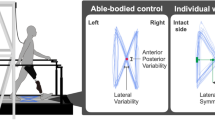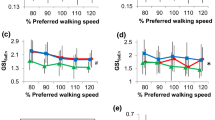Abstract
This study aims to analyze gait variability and stability of individuals with amputation walking on upward (8%), horizontal (0%), and downward (− 8%) inclines, by using linear and nonlinear descriptors. Trunk linear variability and gait spatiotemporal parameters were evaluated. Nonlinear variability (local dynamic stability-LDS), was estimated by the maximum Lyapunov exponent (λ) computed from a trunk marker velocity. The gait descriptors were compared among three distinct groups (N participants): unilateral transtibial amputees (TTA, N = 12); unilateral transfemoral amputees (TFA, N = 13); control group (CT, N = 15). For step width and support phase, the effect of inclination was greater for TFA group, especially in the DOWN condition. Linear variability was higher for amputees (TFA and TTA) especially in the UP condition in the medial-lateral and anterior-posterior directions. TTA and TFA groups presented greater λ values than CT group in medial-lateral direction indicating decreased LDS, but TFA group presented smaller λ values than TTA and CT groups in the V direction. Our findings showed that inclination introduced significant changes in the estimated parameters for all groups, with greater changes for amputee groups. Furthermore, the level of amputation directly affects the analyzed gait parameters being the TFA group the one which presents greater changes.

The objective of this study was to analyze gait variability of individuals with amputation walking on (A) upward (+ 8%), (B) horizontal (0%), and (C) downward (− 8%) inclines, by using linear and nonlinear biomechanical descriptors. Linear measures of variability, such trunk variability and gait spatiotemporal parameters were evaluated. Nonlinear variability was estimated by the exponent of divergence (maximum Lyapunov exponent) of the velocity of a marker fixed in the subject’s trunk while walking on inclined surfaces.



Similar content being viewed by others
References
Gates DH, Scott SJ, Wilken JM, Dingwell JB (2013) Frontal plane dynamic margins of stability in individuals with and without transtibial amputation walking on a loose rock surface. Gait Posture 38:570–575. https://doi.org/10.1016/j.gaitpost.2013.01.024
Grumillier C, Martinet N, Paysant J, André JM, Beyaert C (2008) Compensatory mechanism involving the hip joint of the intact limb during gait in unilateral trans-tibial amputees. J Biomech 41:2926–2931. https://doi.org/10.1016/j.jbiomech.2008.07.018
Van Velzen J, Van Bennekom C, Polomski W, Slootman J, Van der Woude L, Houdijk H (2006) Physical capacity and walking ability after lower limb amputation: a systematic review. Clin Rehabil 20:999–1016. https://doi.org/10.1177/0269215506070700
Kulkarni J, Tolle C, Hirons R, Wright S, Morris J (1996) Falls in patients with lower limb amputations: prevalence and contributing factors. Physiotherapy 82:130–136
Miller WC, Speechley M, Deathe B (2001) The prevalence and risk factors of falling and fear of falling among lower extremity amputees. Arch Phys Med Rehabil 82:1031–1037. https://doi.org/10.1053/apmr.2001.24295
Hunter SW, Batchelor F, Hill KD, Hill A-M, Mackintosh S, Payne M (2016) Risk factors for falls in people with a lower limb amputation: a systematic review. PM R 9:170–180. https://doi.org/10.1016/j.pmrj.2016.07.531
Miller WC, Deathe AB (2011) The influence of balance confidence on social activity after discharge from prosthetic rehabilitation for first lower limb amputation. Prosthetics Orthot Int 35:379–385. https://doi.org/10.1177/0309364611418874
Whitmore MW, Hargrove LJ, Perreault EJ. (2015) Lower-limb muscle activity when walking on different slippery surfaces. 2015 7th Int IEEE/EMBS Conf Neural Eng, IEEE, p. 783–6. https://doi.org/10.1109/NER.2015.7146740.
Liu M, Bohlen P, Huang HH. (2016) Effect of environmental factors on level of trip disturbance: a simulation study. 2016 38th Annu Int Conf IEEE Eng Med Biol Soc, IEEE, p. 5038–41. https://doi.org/10.1109/EMBC.2016.7591859.
Sheehan RC, Rabago CA, Rylander JH, Dingwell JB, Wilken JM (2016) Use of perturbation-based gait training in a virtual environment to address mediolateral instability in an individual with unilateral transfemoral amputation. Phys Ther 96:1896–1904. https://doi.org/10.2522/ptj.20150566
Chen J-L, Gu D-Y. (2013) Local dynamic stability of lower extremity joints in lower limb amputees during slope walking. 35th Annu Int Conf IEEE Eng Med Biol Soc, IEEE, p. 7241–4. https://doi.org/10.1109/EMBC.2013.6611229.
Stergiou N, Decker LM (2011) Human movement variability, nonlinear dynamics, and pathology: is there a connection? Hum Mov Sci 30:869–888. https://doi.org/10.1016/j.humov.2011.06.002
Bruijn SM, Meijer OG, Beek PJ, Van Dieen JH (2013) Assessing the stability of human locomotion: a review of current measures, 20120999. J R Soc Interface 10. https://doi.org/10.1098/rsif.2012.0999
Torburn L, Powers CM, Guiterrez R, Perry J (1995) Energy expenditure during ambulation in dysvascular and traumatic below-knee amputees: a comparison of five prosthetic feet. J Rehabil Res Dev 32:111–119
Leroux A, Fung J, Barbeau H (2002) Postural adaptation to walking on inclined surfaces: I. Normal strategies. Gait Posture 15:64–74. https://doi.org/10.1016/S0966-6362(01)00181-3
McIntosh AS, Beatty KT, Dwan LN, Vickers DR, Ã ASM, Beatty KT et al (2006) Gait dynamics on an inclined walkway. J Biomech 39:2491–2502. https://doi.org/10.1016/j.jbiomech.2005.07.025
Dingwell JB, Marin LC (2006) Kinematic variability and local dynamic stability of upper body motions when walking at different speeds. J Biomech 39:444–452. https://doi.org/10.1016/j.jbiomech.2004.12.014
Lamoth CJC, Ainsworth E, Polomski W, Houdijk H (2010) Variability and stability analysis of walking of transfemoral amputees. Med Eng Phys 32:1009–1014. https://doi.org/10.1016/j.medengphy.2010.07.001
Curtze C, Hof AL, Postema K, Otten B (2011) Over rough and smooth: amputee gait on an irregular surface. Gait Posture 33:292–296. https://doi.org/10.1016/j.gaitpost.2010.11.023
Moraiti CO, Stergiou N, Ristanis S, Vasiliadis HS, Patras K, Lee C, Georgoulis AD (2009) The effect of anterior cruciate ligament reconstruction on stride-to-stride variability. Arthrosc - J Arthrosc Relat Surg 25:742–749. https://doi.org/10.1016/j.arthro.2009.01.016
Strogatz SH (2014) Nonlinear dynamics and chaos: with applications to physics, biology, chemistry, and engineering, 2nd edn. CRC Press, Boca Raton
van Emmerik REA, Ducharme SW, Amado A, Hamill J (2016) Comparing dynamical systems concepts and techniques for biomechanical analysis. J Sport Health Sci 5:1–11. https://doi.org/10.1016/j.jshs.2016.01.013
Scaglioni-Solano P, Aragón-Vargas LF (2014) Age-related differences when walking downhill on different sloped terrains. Gait Posture 41:153–158. https://doi.org/10.1016/j.gaitpost.2014.09.022.
Vieira MF, Rodrigues FB, de Sá e Souza GS, Magnani RM, Lehnen GC, Campos NG et al (2017) Gait stability, variability and complexity on inclined surfaces. J Biomech 54:73–79. https://doi.org/10.1016/j.jbiomech.2017.01.045.
Kang HG, Dingwell JB (2008) Separating the effects of age and walking speed on gait variability. Gait Posture 27:572–577. https://doi.org/10.1016/j.gaitpost.2007.07.009
Vieira MF, Rodrigues FB, de Sá e Souza GS, Magnani RM, Lehnen GC, Andrade AO (2017) Linear and nonlinear gait features in older adults walking on inclined surfaces at different speeds. Ann Biomed Eng 45:1560–1571. https://doi.org/10.1007/s10439-017-1820-x.
Zeni J a, Richards JG, Higginson JS (2008) Two simple methods for determining gait events during treadmill and overground walking using kinematic data. Gait Posture 27:710–714. https://doi.org/10.1016/j.gaitpost.2007.07.007
de Sá e Souza GS, Rodrigues FB, Andrade AO, Vieira MF (2017) A simple, reliable method to determine the mean gait speed using heel markers on a treadmill. Comput Methods Biomech Biomed Eng 20:901–904. https://doi.org/10.1080/10255842.2017.1309395
Hak L, Houdijk H, Beek PJ, Van Dieën JH (2013) Steps to take to enhance gait stability: the effect of stride frequency, stride length, and walking speed on local dynamic stability and margins of stability. PLoS One 8:e82842. https://doi.org/10.1371/journal.pone.0082842
Prince F, Winter D, Stergiou P, Walt S (1994) Anticipatory control of upper body balance during human locomotion. Gait Posture 2:19–25. https://doi.org/10.1016/0966-6362(94)90013-2
Toebes MJP, Hoozemans MJM, Furrer R, Dekker J, van Dieën JH (2015) Associations between measures of gait stability, leg strength and fear of falling. Gait Posture 41:76–80. https://doi.org/10.1016/j.gaitpost.2014.08.015
Dingwell JB, Cusumano JP, Cavanagh PR, Sternad D (2001) Local dynamic stability versus kinematic variability of continuous overground and treadmill walking. J Biomech Eng 123:27–32
Rosenstein MT, Collins JJ, De Luca CJ (1993) A practical method for calculating largest Lyapunov exponents from small data sets. Phys D Nonlinear Phenom 65:117–134. https://doi.org/10.1016/0167-2789(93)90009-P
Terrier P, Dériaz O (2013) Non-linear dynamics of human locomotion: effects of rhythmic auditory cueing on local dynamic stability. Front Physiol 4:230. 1–13. https://doi.org/10.3389/fphys.2013.00230
Robertson DGE, Caldwell GE, Hamill J, Kamen G, Whittlessey SN (2014) Research methods in biomechanics, 2nd edn. Human Kinetics, Champaign
Stenum J, Bruijn SM, Jensen BR (2014) The effect of walking speed on local dynamic stability is sensitive to calculation methods. J Biomech 47:3776–3779. https://doi.org/10.1016/j.jbiomech.2014.09.020
Raffalt PC, Kent JA, Wurdeman SR, Stergiou N (2019) Selection procedures for the largest Lyapunov exponent in gait biomechanics. Ann Biomed Eng 47:913–923. https://doi.org/10.1007/s10439-019-02216-1
Fraser AM (1986) Using mutual information to estimate metric entropy. In: Mayer-Kress G (ed) Dimens. Entropies Chaotic Syst. Springer, Berlin, pp 82–91. https://doi.org/10.1007/978-3-642-71001-8_11.
Kennel MB, Brown R, Abarbanel HDI (1992) Determining embedding dimension for phase-space reconstruction using a geometrical construction. Phys Rev A 45:3403–3411. https://doi.org/10.1103/PhysRevA.45.3403
Reynard F, Terrier P (2014) Local dynamic stability of treadmill walking: intrasession and week-to-week repeatability. J Biomech 47:74–80. https://doi.org/10.1016/j.jbiomech.2013.10.011
Winter DA, Patla AE, Frank JS, Walt SE (1990) Biomechanical walking pattern changes in the fit and healthy elderly. Phys Ther 70:340–347. https://doi.org/10.1093/ptj/70.6.340
Jaegers SMHJ, Arendzen JH, de Jongh HJ (1995) Prosthetic gait of unilateral transfemoral amputees: a kinematic study. Arch Phys Med Rehabil 76:736–743. https://doi.org/10.1016/S0003-9993(95)80528-1
Hof AL, van Bockel RM, Schoppen T, Postema K (2007) Control of lateral balance in walking. Experimental findings in normal subjects and above-knee amputees. Gait Posture 25:250–258. https://doi.org/10.1016/j.gaitpost.2006.04.013
Wurdeman SR, Myers SA, Stergiou N (2013) Transtibial amputee joint motion has increased attractor divergence during walking compared to non-amputee gait. Ann Biomed Eng 41:806–813. https://doi.org/10.1007/s10439-012-0705-2
Wurdeman SR, Myers SA, Jacobsen AL, Stergiou N (2014) Adaptation and prosthesis effects on stride-to-stride fluctuations in amputee gait. PLoS One 9:e100125. https://doi.org/10.1371/journal.pone.0100125
Rodrigues FB, Magnani RM, Lehnen GC, Souza GSDSE, Andrade AO, Vieira MF (2017) Effects of backpack load and positioning on nonlinear gait features in young adults. Ergonomics 61:720–728. https://doi.org/10.1080/00140139.2017.1413213
Rankin BL, Buffo SK, Dean JC (2014) A neuromechanical strategy for mediolateral foot placement in walking humans. J Neurophysiol 112:374–383. https://doi.org/10.1152/jn.00138.2014
Vrieling AH, van Keeken HG, Schoppen T, Otten E, Halbertsma JPK, Hof AL, Postema K (2008) Uphill and downhill walking in unilateral lower limb amputees. Gait Posture 28:235–242. https://doi.org/10.1016/j.gaitpost.2007.12.006
Wurdeman SR, Myers SA, Stergiou N (2014) Amputation effects on the underlying complexity within transtibial amputee ankle motion. Chaos 24:013140. https://doi.org/10.1063/1.4869580
Funding
The authors are thankful to governmental agencies CNPq, CAPES, FAPEG, and FAPEMIG for supporting this study. Adriano O. Andrade and Marcus Fraga Vieira are a Fellow of CNPq, Brazil (304818/2018-6 and 306205/2017-3, respectively).
Author information
Authors and Affiliations
Corresponding author
Additional information
Publisher’s note
Springer Nature remains neutral with regard to jurisdictional claims in published maps and institutional affiliations.
Rights and permissions
About this article
Cite this article
Rodrigues, F.B., Andrade, A.O. & Vieira, M.F. Effects of inclined surfaces on gait variability and stability in unilateral lower limb amputees. Med Biol Eng Comput 57, 2337–2346 (2019). https://doi.org/10.1007/s11517-019-02042-6
Received:
Accepted:
Published:
Issue Date:
DOI: https://doi.org/10.1007/s11517-019-02042-6




